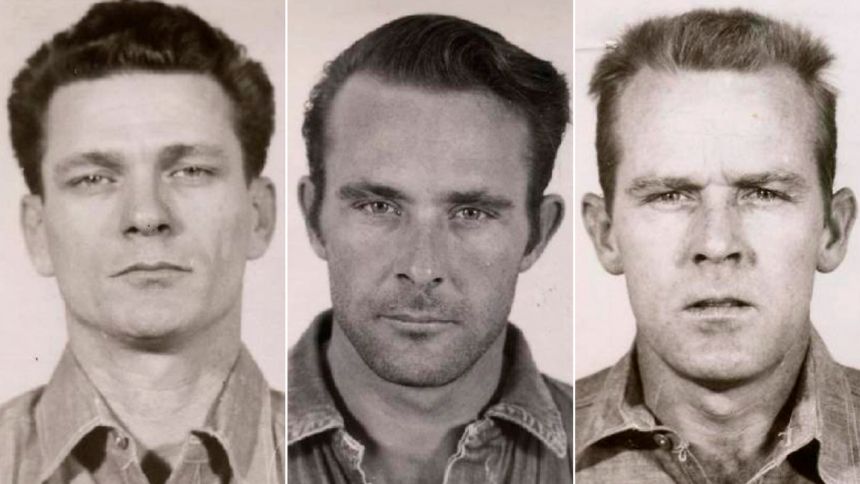With two escapees still on the run after a mass jailbreak in New Orleans and an ex-police chief convicted of murder on the loose in Arkansas, high-profile cases of daring breakouts have captured headlines for more than a week.
As of Tuesday, authorities in Louisiana were still hunting for Antoine Massey and Derrick Groves, more than a week after the two men and eight other – now captured – inmates escaped through a hole in the wall behind a cell toilet in a jail in Orleans Parish.
The sheriff has said the breakout was a “coordinated effort” involving inside help. Police have charged more than a dozen people with helping the inmates. Adding to the intrigue is Massey’s background as a serial escapee.
Meanwhile in Arkansas, multiple law enforcement agencies are trying to track down Grant Hardin, a former police chief for Gateway, a small town near the Missouri border, after his escape from North Central Unit prison in Calico Rock.

Hardin – who was serving decades-long sentences for rape and murder – was spotted on prison surveillance cameras wearing “a makeshift outfit designed to mimic law enforcement” as he slipped out, according to the Arkansas Department of Corrections.
Americans are no strangers to jailbreaks. Nearly 1,400 individuals were sentenced by federal courts for escaping between 2019 and 2023, according to the United States Sentencing Commission. And that’s just at the federal level and those who were recaptured and sentenced.
An American man also holds the Guinness World Record for the longest known escape by a recaptured prisoner. The title belongs to Leonard T. Fristoe, who was convicted of killing two sheriff’s deputies in 1920. He fled the Nevada State Prison in Carson City three years later and roamed free under the name Claude R. Willis for nearly 46 years, according to the Guinness World Record. His son handed him over in 1969.
Here’s a list of headline-grabbing jailbreaks that captured the nation’s attention over the years.
Made for TV




This forbidden prison romance was so captivating it was turned into a seven-episode crime series directed by Ben Stiller.
“Escape at Dannemora” is based on the 2015 prison break in northern New York state by David Sweat and Richard Matt, who developed a romantic relationship with prison tailor Joyce Mitchell and convinced her to help them. They escaped after cutting through steel walls with hacksaw blades Mitchell smuggled into the prison.
It sparked a weeks-long, nationwide manhunt that ended with Matt being shot and killed by police and Sweat being captured near the Canada border.
Mitchell confessed to helping the inmates and was sentenced to up to seven years.
Escape from ‘The Rock’




On June 11, 1962, three prisoners escaped from the notorious Alcatraz prison, a former US military base located on a small island off the coast of San Francisco.
Frank Morris and brothers Clarence and John Anglin, all in their 30s, shimmied with a homemade raft through hidden holes in their cell walls, climbed through a ventilation duct onto the roof and shoved off from the island fortress into the freezing, choppy waters of San Francisco Bay.
This escape was also fit for big screen. Clint Eastwood starred in the 1979 telling, which portrayed the unbelievably elaborate lengths the prisoners took to break out.
That included making fake plaster heads of themselves – complete with real human hair – to fool the guards on the night of the escape and secretly assembling a makeshift raft and life vests out of more than 50 stolen raincoats.
While Morris and the Anglin brothers were never found, fans of outlaw drama – and some of the prisoners’ own family members – are convinced they actually made it to shore and lived their lives hidden from justice and the public eye.
Alcatraz, now popular tourist destination operated by the National Park Service, was itself cast back in the spotlight earlier this month when President Donald Trump said he would direct federal agencies to reopen the prison to “house America’s most ruthless and violent Offenders.”
Trump later told reporters it was “just an idea” he had because of “radicalized judges” citing due process concerns and ruling against some of his tactics to crack down on illegal immigration.
‘El Chapo’
Despite the reportedly cushy conditions at Mexico’s Puente Grande prison, drug cartel boss Joaquin “El Chapo” Guzman Loera in 2001 escaped from the prison in a laundry cart, with 12 years left in his sentence.
Guzman remained on the run until 2014, when he was captured at a hotel in the Pacific beach town of Mazatlán.
A year later, however, he would break out of a maximum-security prison again. This time, he got out through a mile-long tunnel.
It took nearly six months for investigators to find him again at a hideaway in the coastal city of Los Mochis in January 2016. He was later convicted in the US for running an industrial-scale drug smuggling operation and is now serving his sentence at a maximum-security prison in Florence, Colorado.
A ‘special relationship’
Corrections official Vicky White and prisoner Casey White fled a detention facility in Lauderdale County, Alabama, on April 29, 2022.
They were finally captured by authorities on Monday, May 9, in Evansville, Indiana. In those 11 days, the guard and the prisoner, who had formed a “special relationship” at the county jail, traveled more than 200 miles through at least four states, with tens of thousands of dollars in cash to pay for clothes, wigs, hotel rooms and several vehicles.
Officers took Casey White into custody, while Vicky White died from what investigators believed to be a self-inflicted gunshot wound.
Casey White was booked back into the William E. Donaldson Correctional Facility in Bessemer – the same prison where he had been at the start of that year.
Ted Bundy




Serial killer Ted Bundy was arrested for the final time on February 15, 1978.
He had been previously arrested on murder charges in Colorado but escaped from custody, before being captured in Aspen a few days later.
Months after that Bundy escaped again, prompting a nationwide manhunt. While a fugitive in Florida, he killed two college students and a 12-year-old girl.
Six weeks after escaping, Bundy was apprehended for a third and final time in Pensacola in a stolen car.
He was convicted on three counts of murder, sentenced to death in the electric chair and executed on January 24, 1989.
Why jailbreaks happen
Several experts have told CNN that when jails are short of staff, employees are prone to making mistakes, which is the most consistent factor contributing to prison breaks.
Joseph Gunja, a security consultant who previously worked as a warden for several federal prisons, says even small mistakes can lead to problems.
“Sometimes it’s just a small mistake, like, you don’t pat search somebody, or you don’t search a cell, or you let an inmate go into an area he shouldn’t be… those things pile up,” Gunja told CNN.
Aging facilities with faulty equipment can contribute to escapes, experts also said.
Orleans Parish Sheriff Susan Hutson has cited understaffing as a key contributor to this month’s jailbreak. The jail is only about 60% staffed, and 150 more deputies are needed, she said.
She also singled out locks as defective and called for funding to update correctional facilities.
During manhunts, police rely heavily on local communities to tip them off about the sighting of escaped inmates.
A fractured relationship with the public would make it harder for police to recapture escapees, according to Bryce Peterson, a research scientist who studies law enforcement and corrections facilities at CNA, a security-focused research organization.
CNN’s Karina Tsui, Cindy Von Quednow, Matt Rehbein, Taylor Romine, Chris Boyette and Zoe Sottile contributed to this report.
This post was originally published on this site be sure to check out more of their content.









